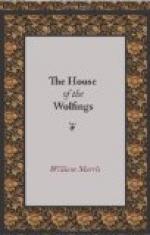But over the dais there hung by chains and pulleys fastened to a tie-beam of the roof high aloft a wondrous lamp fashioned of glass; yet of no such glass as the folk made then and there, but of a fair and clear green like an emerald, and all done with figures and knots in gold, and strange beasts, and a warrior slaying a dragon, and the sun rising on the earth: nor did any tale tell whence this lamp came, but it was held as an ancient and holy thing by all the Markmen, and the kindred of the Wolf had it in charge to keep a light burning in it night and day for ever; and they appointed a maiden of their own kindred to that office; which damsel must needs be unwedded, since no wedded woman dwelling under that roof could be a Wolfing woman, but would needs be of the houses wherein the Wolfings wedded.
This lamp which burned ever was called the Hall-Sun, and the woman who had charge of it, and who was the fairest that might be found was called after it the Hall-Sun also.
At the other end of the hall was the Woman’s-Chamber, and therein were the looms and other gear for the carding and spinning of wool and the weaving of cloth.
Such was the Roof under which dwelt the kindred of the Wolfings; and the other kindreds of the Mid-mark had roofs like to it; and of these the chiefest were the Elkings, the Vallings, the Alftings, the Beamings, the Galtings, and the Bearings; who bore on their banners the Elk, the Falcon, the Swan, the Tree, the Boar, and the Bear. But other lesser and newer kindreds there were than these: as for the Hartings above named, they were a kindred of the Upper-mark.
CHAPTER II—THE FLITTING OF THE WAR-ARROW
Tells the tale that it was an evening of summer, when the wheat was in the ear, but yet green; and the neat-herds were done driving the milch-kine to the byre, and the horseherds and the shepherds had made the night-shift, and the out-goers were riding two by two and one by one through the lanes between the wheat and the rye towards the meadow. Round the cots of the thralls were gathered knots of men and women both thralls and freemen, some talking together, some hearkening a song or a tale, some singing and some dancing together; and the children gambolling about from group to group with their shrill and tuneless voices, like young throstles who have not yet learned the song of their race. With these were mingled dogs, dun of colour, long of limb, sharp-nosed, gaunt and great; they took little heed of the children as they pulled them about in their play, but lay down, or loitered about, as though they had forgotten the chase and the wild-wood.
Merry was the folk with that fair tide, and the promise of the harvest, and the joy of life, and there was no weapon among them so close to the houses, save here and there the boar-spear of some herdman or herd-woman late come from the meadow.




